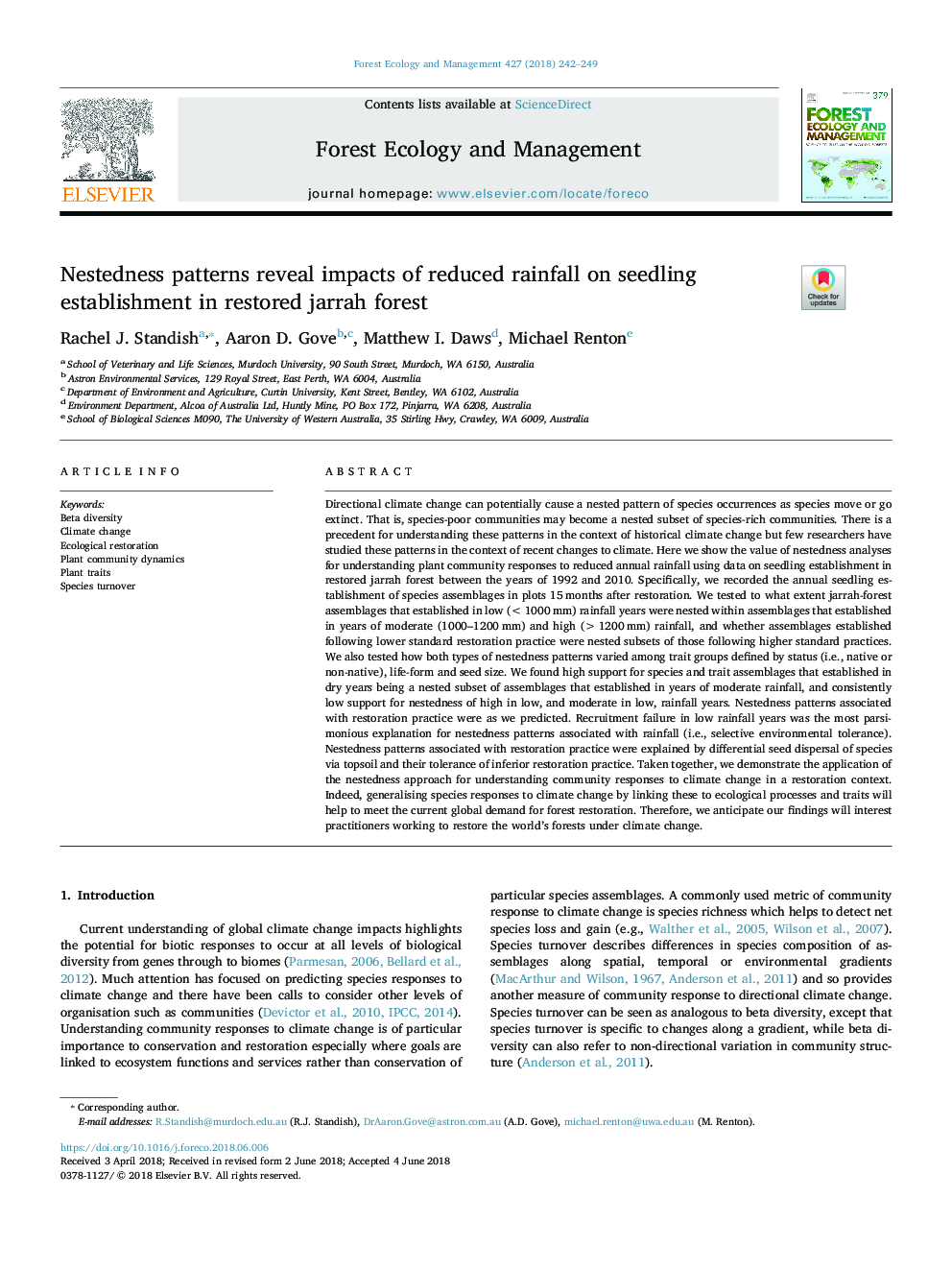| کد مقاله | کد نشریه | سال انتشار | مقاله انگلیسی | نسخه تمام متن |
|---|---|---|---|---|
| 6541514 | 1421333 | 2018 | 8 صفحه PDF | دانلود رایگان |
عنوان انگلیسی مقاله ISI
Nestedness patterns reveal impacts of reduced rainfall on seedling establishment in restored jarrah forest
ترجمه فارسی عنوان
الگوهای نشتی اثرات کاهش بارندگی را در تأسیس گیاهچه در جنگل بازسازی شده جرم نشان می دهد
دانلود مقاله + سفارش ترجمه
دانلود مقاله ISI انگلیسی
رایگان برای ایرانیان
کلمات کلیدی
تنوع بتا، تغییر آب و هوا، بازسازی محیطی، دینامیک گیاهی جامعه، صفات گیاهی، جابجایی گونه ها،
موضوعات مرتبط
علوم زیستی و بیوفناوری
علوم کشاورزی و بیولوژیک
بوم شناسی، تکامل، رفتار و سامانه شناسی
چکیده انگلیسی
Directional climate change can potentially cause a nested pattern of species occurrences as species move or go extinct. That is, species-poor communities may become a nested subset of species-rich communities. There is a precedent for understanding these patterns in the context of historical climate change but few researchers have studied these patterns in the context of recent changes to climate. Here we show the value of nestedness analyses for understanding plant community responses to reduced annual rainfall using data on seedling establishment in restored jarrah forest between the years of 1992 and 2010. Specifically, we recorded the annual seedling establishment of species assemblages in plots 15â¯months after restoration. We tested to what extent jarrah-forest assemblages that established in low (<1000â¯mm) rainfall years were nested within assemblages that established in years of moderate (1000-1200â¯mm) and high (>1200â¯mm) rainfall, and whether assemblages established following lower standard restoration practice were nested subsets of those following higher standard practices. We also tested how both types of nestedness patterns varied among trait groups defined by status (i.e., native or non-native), life-form and seed size. We found high support for species and trait assemblages that established in dry years being a nested subset of assemblages that established in years of moderate rainfall, and consistently low support for nestedness of high in low, and moderate in low, rainfall years. Nestedness patterns associated with restoration practice were as we predicted. Recruitment failure in low rainfall years was the most parsimonious explanation for nestedness patterns associated with rainfall (i.e., selective environmental tolerance). Nestedness patterns associated with restoration practice were explained by differential seed dispersal of species via topsoil and their tolerance of inferior restoration practice. Taken together, we demonstrate the application of the nestedness approach for understanding community responses to climate change in a restoration context. Indeed, generalising species responses to climate change by linking these to ecological processes and traits will help to meet the current global demand for forest restoration. Therefore, we anticipate our findings will interest practitioners working to restore the world's forests under climate change.
ناشر
Database: Elsevier - ScienceDirect (ساینس دایرکت)
Journal: Forest Ecology and Management - Volume 427, 1 November 2018, Pages 242-249
Journal: Forest Ecology and Management - Volume 427, 1 November 2018, Pages 242-249
نویسندگان
Rachel J. Standish, Aaron D. Gove, Matthew I. Daws, Michael Renton,
